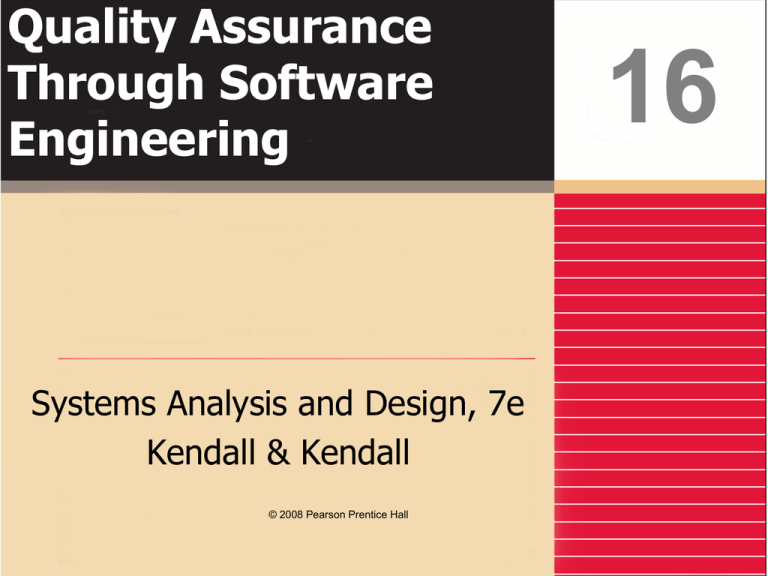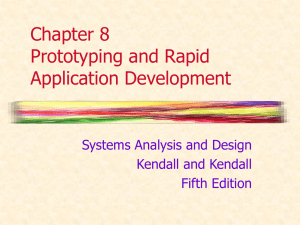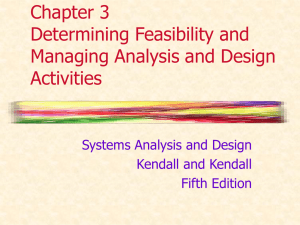
Quality Assurance
Through Software
Engineering
Systems Analysis and Design, 7e
Kendall & Kendall
© 2008 Pearson Prentice Hall
16
Major Topics
•
•
•
•
•
•
•
•
Six Sigma
Quality assurance
Walkthroughs
Structure charts
Modules
Data and control passing
Documentation
Testing
Kendall & Kendall
16-2
Six Sigma
•
•
•
•
•
A culture built on quality
Uses a top-down approach
Project leader is called a Black Belt
Project members are called Green Belts
Master Black Belts have worked on
many projects and are available as a
resource to project teams
Kendall & Kendall
16-3
Figure 16.1 Every systems analyst should
understand the methodology and philosophy of
Six Sigma
Kendall & Kendall
16-4
Responsibility for Total Quality
Management
• Full organizational support of
management must exist
• Early commitment to quality from the
analyst and business users
Kendall & Kendall
16-5
Structured Walkthroughs
• One of the strongest quality management
actions is to do structured walkthroughs
routinely
• Use peer reviewers to monitor the system's
programming and overall development
• Point out problems
• Allow the programmer or analyst to make
suitable changes
Kendall & Kendall
16-6
Involved in Structured
Walkthroughs
• The person responsible for the part of
the system being reviewed
• A walkthrough coordinator
• A programmer or analyst peer
• A peer who takes notes about
suggestions
Kendall & Kendall
16-7
Systems Design and
Development
• Bottom-up
• Top-down
• Modular
Kendall & Kendall
16-8
Bottom-Up Design
• Identifying the processes that need
computerization as they arise
• Analyzing them as systems
• Either coding or purchasing packaged
software to meet the immediate
problem
Kendall & Kendall
16-9
The Top-Down Approach
• Top-down design allows the systems
analyst to ascertain overall
organizational objectives and how they
are best met in an overall system
• The system is divided into subsystems
and their requirements
Kendall & Kendall
16-10
Figure 16.3 Using the top-down approach to
first ascertain overall organizational objectives
Kendall & Kendall
16-11
Advantages of the Top-Down
Approach
• Avoiding the chaos of attempting to
design a system all at once
• Enables separate systems analysis
teams to work in parallel on different
but necessary subsystems
• Prevents losing sight of what the
system is suppose to do
Kendall & Kendall
16-12
Modular Development
• Breaking the programming into logical,
manageable portions or modules
• Works well with top-down design
• Each individual module should be
functionally cohesive, accomplishing
only one function
Kendall & Kendall
16-13
Advantages of Modular
Programming
• Modules are easier to write and debug
• Modules are easier to maintain
• Modules are easier to grasp because
they are self-contained subsystems
Kendall & Kendall
16-14
Guidelines for Modular
Programming
• Keep each module to a manageable size
• Pay particular attention to the critical
interfaces
• Minimize the number of modules the
user must modify when making
changes
• Maintain the hierarchical relationships
set up in the top-down phases
Kendall & Kendall
16-15
Modularity in the Windows
Environment
There are two systems to link programs
in Microsoft Windows:
• Dynamic Data Exchange (DDE) shares
code by using Dynamic Link Library (DLL)
files
• Object Linking and Embedding (OLE) ties
in application data and graphics
Kendall & Kendall
16-16
Using Structure Charts to Design
Systems
• The recommended tool for designing a
modular, top-down system is a
structure chart
• A structure chart is simply a diagram
consisting of rectangular boxes,
representing the modules, and
connecting lines
Kendall & Kendall
16-17
Figure 16.4 A structure diagram encourages
top-down design using modules
Kendall & Kendall
16-18
Figure 16.5
Kendall & Kendall
16-19
Data Couples and Control Flags
• The fewer control flags and data couples in the
system, the easier it is to change the system
• Control flags govern which portion of a module is
to be executed and associated with
IF…THEN…ELSE…and other similar statements
• Data coupling is when only data required is
passed through the data couple
• Stamp coupling is when excessive data is passed
through the data couple
Kendall & Kendall
16-20
Figure 16.8 Creating reusable
modules
Kendall & Kendall
16-21
Figure 16.9 The loop and diamond are two symbols
that indicate special action in a structure chart
Kendall & Kendall
16-22
Drawing a Structure Chart
• A data flow diagram may be used to
create a structure chart
• Indicates the sequence of the modules
• Indicates modules subordinate to a higher
module
Kendall & Kendall
16-23
Types of Modules
• Control modules
• Transformational modules
• Functional modules
Kendall & Kendall
16-24
Control Modules
• Found near the top of the structure
chart and contain the logic for
performing the lower-level modules
• May or may not be represented on the
data flow diagram
• Usually contains IF, Perform, and DO
statements
• Should not be very large in size
Kendall & Kendall
16-25
Transformational Modules
• Created from a data flow diagram
• Usually perform only one task
• Have mixed statements, IF and
PERFORM or DO statements and many
detailed statements such as MOVE and
ADD
Kendall & Kendall
16-26
Functional Modules
• Perform only one task
• The easiest to code, debug, and
maintain
Kendall & Kendall
16-27
Figure 16-13 A structure chart for
adding hotel guest reservations online
Kendall & Kendall
16-28
Module Subordination
• A subordinate module is one lower on
the structure chart called by another
module higher in the structure
• Allowing a lower-level module to
perform a task not required by the
calling module is called improper
subordination
Kendall & Kendall
16-29
Software Engineering and
Documentation
• The total quality assurance effort
requires that programs be documented
properly
• Documentation
• Allows you to “see” the system without
having to interact with it
• Provides an overview of the system itself
• Shortens time to perform maintenance
Kendall & Kendall
16-30
System Documentation
• Pseudocode
• Procedure manuals
• The FOLKLORE method
Kendall & Kendall
16-31
Pseudocode
• Similar to structured English
• It is not a particular type of
programming code, but it can be used
as an intermediate step for developing
program code
Kendall & Kendall
16-32
Figure 16.16 Using pseudocode to depict a subscription
update service for a newspaper conglomerate
Kendall & Kendall
16-33
Procedure Manuals
• The English-language component of
documentation
• Key sections
•
•
•
•
•
•
Kendall & Kendall
Introduction
How to use the software
What to do if things go wrong
A technical reference section
An index
Information on how to contact the manufacturer
16-34
Procedure Manuals
(Continued)
• Procedure manual complaints
• They are poorly organized
• It is hard to find needed information
• The specific case in question does not
appear in the manual
• The manual is not written in plain English
Kendall & Kendall
16-35
Web Documentation
•
•
•
•
•
FAQ (Frequently Asked Questions)
Help desks
Technical support
Fax-back services
Downloading updates
Kendall & Kendall
16-36
The FOLKLORE Method
• Collects information in the categories
•
•
•
•
Kendall & Kendall
Customs
Tales
Sayings
Art forms
16-37
Figure 16.18 Customs, tales, sayings, and art forms
used in the FOLKLORE method of documentation apply
to information systems
Kendall & Kendall
16-38
Choosing a Design and
Documentation Technique
• Is it compatible with existing
documentation
• Is it understood by others in the
organization
• Does it allow you to return to working
on the system after you have been
away from it for a period of time
Kendall & Kendall
16-39
Choosing a Design and Documentation
Technique (Continued)
• Is it suitable for the size of the system
you are working on
• Does it allow for a structured design
approach if that is considered to be
more important than other factors
• Does it allow for easy modification
Kendall & Kendall
16-40
Testing, Maintenance, and
Auditing
• The testing process
• Maintenance practices
• Auditing
Kendall & Kendall
16-41
The Testing Process
•
•
•
•
Program testing with test data
Link testing with test data
Full system testing with test data
Full system testing with live data
Kendall & Kendall
16-42
Figure 16.19 Programmers, analysts, operators, and
users all play different roles in testing software and
systems
Kendall & Kendall
16-43
Program Testing with Test
Data
• Desk check programs
• Test with both valid and invalid data
• Check output for errors and make any
needed corrections
Kendall & Kendall
16-44
Link Testing with Test Data
• Also referred to as string testing
• Checks to see if programs that are
interdependent actually work together
as planned
• Test for normal transactions
• Test with invalid data
Kendall & Kendall
16-45
Full System Testing with
Test Data
• Adequate documentation in procedure
manuals
• Are procedure manuals clear enough
• Do work flows actually “flow”
• Is output correct and do users
understand this output
Kendall & Kendall
16-46
Full System Testing with Live
Data
• Comparison of the new system’s output
with what you know to be correctly
processed output
• Only small amounts of live data are
used
Kendall & Kendall
16-47
Maintenance Practices
• Reduce maintenance costs
• Improve the existing software
• Update software in response to the
changing organization
• Ensure channels for feedback
• Classification scheme
Kendall & Kendall
16-48
Auditing
• Having an expert who is not involved in
setting up or using the system examine
information in order to ascertain its reliability
• There are internal and external auditors
• Internal auditors study the controls used in
the information system to make sure that
they are adequate
• External auditors are used when the
information system processes data that
influences a company’s financial statements
Kendall & Kendall
16-49






